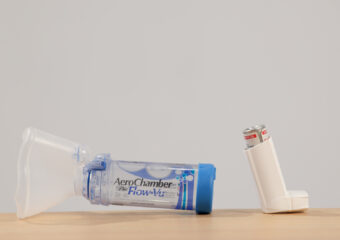A spacer is a tube or chamber that attaches to your puffer - a metered-dose inhaler (MDI). It makes it easier to breathe in your asthma medication and helps more of the medication reach your lungs.
The spacer connects to your puffer’s mouthpiece and gives medication the ‘space’ to slow down so you can breathe it in slowly and deeply. The spacer holds the medication so you can take as many breaths as needed. This helps the medication get straight to where it’s needed in your lungs, with less medication ending up in your mouth and throat where it can lead to irritation, hoarseness or infections. A spacer can also make it easier to coordinate pressing your puffer and breathing in.
The spacer helps the medication reach the small airways where it is most needed and this is important for both adults and children. Spacers should be used by:
All the latest research shows that a puffer with spacer works just as well as a nebuliser for treating asthma symptoms, including during an asthma attack. A puffer with spacer is also simpler, cheaper and handier, is much more portable, and has fewer side-effects.
A small volume spacer with a tightly fitting face mask should be used for children younger than 4 years or for people who cannot close their lips tightly around the mouthpiece of a spacer.
A mask can also help people who have difficulty coordinating breaths. Some adults or children may find it difficult to coordinate pressing the puffer with taking a deep breath or may not be able to maintain a tight seal with the spacer mouthpiece.
There are many different types, brands and sizes of spacers available including plastic chamber spacers, collapsible spacers and disposable cardboard spacers.
Ask your pharmacist, nurse or asthma educator about which spacer might be best for you or your child. Look for one that you can put together easily and that will be convenient to use.
Our wall chart that is designed for health for health professionals can also help you identify types of spacers: nationalasthma.org.au/living-with-asthma/resources/health-professionals/charts
For more tips and to check you are using your spacer correctly, including how to use a mask with a spacer, view our ‘how-to video’ about inhaler and spacer use.
Clean your spacer weekly and after you have recovered from a cold or respiratory infection. Your spacer may become a bit cloudy over time, but it shouldn’t be mouldy or brown. Your spacer should be replaced after 12 months of use or according to the manufacturer’s instructions.
To clean your spacer:
Please read the priming and cleaning instructions for your spacer or ask your pharmacist, nurse or asthma educator. Disposable cardboard spacers do not need to be primed or cleaned.
Your spacer should be checked by your pharmacist, nurse or asthma educator every 6 to 12 months to check the structure is intact (e.g. no cracks) and the valve is working properly.
It is important to note that information contained in this brochure is not intended to replace professional medical advice. Any questions regarding a medical diagnosis or treatment should be directed to a medical practitioner.
© 2025 National Asthma Council Australia.

It's easier to learn how to use your inhaler or puffer when someone shows you how.

Different types of puffers and inhalers need to be cleaned in different ways
